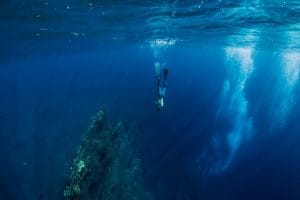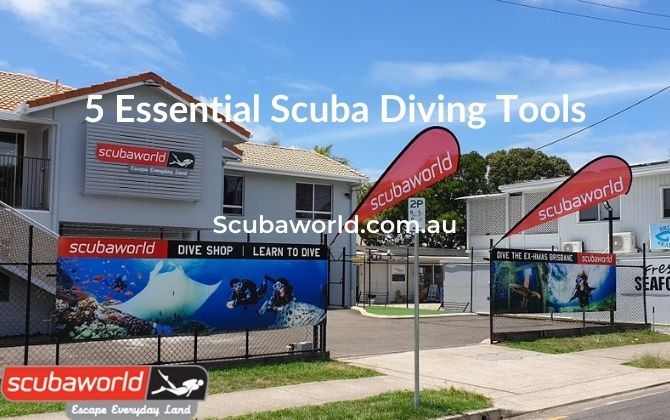
Why Scuba Divers Should Try Freediving: A Personal Perspective from an Scuba diving and Freediving Instructor
Hey everyone, I’m Matt, co-director of OceanSense Freediving here on the Sunny Coast. Over the

Welcome to the fantastic world of scuba diving. If you have dreams of joining the scuba diving community, then you are in for more than just a treat. There is a whole world of adventure beneath those waters, waiting and ready to welcome you. But as much as scuba diving is exciting, it can also be dangerous if you do not have the right tools or equipment.
This article brings to you the five essential scuba diving tools that you’ll need to make your underwater adventure both fun and safe.
You should bear in mind that for most beginners, your first lessons will probably begin in a pool with a diving instructor. Most diving schools have all the essential equipment you will need in stock. So, there will be no need to buy from elsewhere.
A scuba diving mask has one job, that is to give your eyes enough airspace to be able to focus and see your surroundings underwater. These masks come in different colours and sizes, with some coming with special features – for example, with lenses. Just make sure you pick out the right mask that is a good fit.
For most newbies, a simple but well-made snorkel will be more than enough. Most snorkels come in basic and simple designs. However, there are some with minor upgrades that can make some difference, especially if you plan on enjoying some leisurely snorkelling experience around the reefs. Some instructors may provide you with a durable snorkel as part of your lesson package.
Scuba diving fins are also a piece of essential equipment. Because of the dense nature of water, you will need the fins to help propel you with enough force to move you around. Fins are also available in different sizes and colours.
The most important thing is to find the right fit. There are full-foot fins that are comparatively lighter, and open-foot fins that are on the bulkier side. However, if your feet are not used to the rigours of wearing fins, they can be subjected to a lot of friction that will cause blisters that can be very uncomfortable while you swim.
The blisters usually occur because of the friction your skin subject to while you try to move through the water. But don’t worry, almost every beginner goes through this. Just make sure you wear a pair of underwater socks to provide a layer of comfort before you place your feet in the rubber fins. Also, apply creams to your feet that would reduce swelling and blistering. The more your practice, the quicker your feet would adjust to motions and weight of the water and the fins.
You will be required to own a wetsuit or drysuit as a form of exposure protection. The choice will depend on what your prerogative or, based on the advice of your instructor, you would be provided with one, where your dive course will take place, and where you plan to scuba dive after your training.
Getting a good suit that fits perfectly is far better than settling for one. If it is loose, it will allow cold water in and put your skin at risk of dehydration and other health complications. Wetsuits are available in different thickness and configurations for different diving conditions.
Alternatively, you can also skip getting a wetsuit until you are done with your training and opt for a drysuit if you are going to be focusing on cold water diving.
Now that you have the pieces of equipment mentioned above, there is a combination of other equipment you need to have the complete set. We call it the “basic life support equipment.” This is a dive computer we use to make it less complicated for you to plan your dives. Over the years, scuba divers have regarded these computers as essential scuba diving equipment. The computer also ensures that your dives are accurate and safe. It tracks your dive and recalculates your nitrogen and oxygen levels whenever there is a change in your depth.
Apart from the beautiful landscape, interesting culture and people of Australia, the majestic Indian Ocean surrounding the land is worth exploring. Take on scuba diving today. Prepare with us so you can safely enjoy the beauty of the underwater kingdom that the Indian Ocean has in store for you. With these five essential scuba diving tools and the right skillset from us, you are bound to have a wholesome experience of Australia.

Hey everyone, I’m Matt, co-director of OceanSense Freediving here on the Sunny Coast. Over the
Join us Thursday 30th Jan at 5:30pm to hear David Mullins talk about nudibranch defences
Dear members, I would like to take this opportunity to inform you about a few